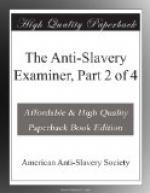[Footnote A: [Greek: Osoi.] See Passow’s Schneider.]
[Footnote B: [Greek: De.] See Passow.]
2. The first class are described as “under the yoke”—a yoke from which they were, according to the apostle, to make their escape if possible.[C] If not, they must in every way regard the master with respect—bowing to his authority, working his will, subserving his interests so far as might be consistent with Christian character.[D] And this, to prevent blasphemy—to prevent the pagan master from heaping profane reproaches upon the name of God and the doctrines of the gospel. They should beware of rousing his passions, which, as his helpless victims, they might be unable to allay or withstand.
[Footnote C: See 1 Cor. vii. 21—[Greek: All ei kai d u n a s a i eleutheros genesthai.]]
[Footnote D: 1 Cor. vii. 23—[Greek: Mae ginesthe douloi anthropon.]]
But all the servants whom the apostle addressed were not “under the yoke"[E]—an instrument appropriate to cattle and to slaves. These he distinguishes from another class, who instead of a “yoke”—the badge of a slave—had “believing masters.” To have a “believing master,” then, was equivalent to freedom from “the yoke." These servants were exhorted not to despise their masters. What need of such an exhortation, if their masters had been slaveholders, holding them as property, wielding them as mere instruments, disposing of them as “articles of merchandise?” But this was not consistent with believing. Faith, “breaking every yoke,” united master and servants in the bonds of brotherhood. Brethren they were, joined in a relation which, excluding the yoke,[F] placed them side by side on the ground of equality, where, each in his appropriate sphere, they might exert themselves freely and usefully, to the mutual benefit of each other. Here, servants might need to be cautioned against getting above their appropriate business, putting on airs, despising their masters, and thus declining or neglecting their service.[G] Instead of this, they should be, as emancipated slaves often have been,[H] models of enterprise, fidelity, activity, and usefulness—especially as their masters were “worthy of their confidence and love,” their helpers in this well-doing.[I]
[Footnote E: See Lev. xxvi. 13; Isa. lviii. 6, 9.]
[Footnote F: Supra p. 47.]
[Footnote G: See Matt. vi. 24.]
[Footnote H: Those, for instance, set free by that “believing master” James G. Birney.]
[Footnote I: The following exposition is from the pen of ELIZUR WRIGHT, JR.:—“This word [Greek: antilambanesthai,] in our humble opinion, has been so unfairly used by the commentators, that we feel constrained to take its part. Our excellent translators, in rendering the clause ‘partakers of the benefit,’ evidently lost sight of the component preposition, which expresses the opposition of reciprocity, rather than the connection




